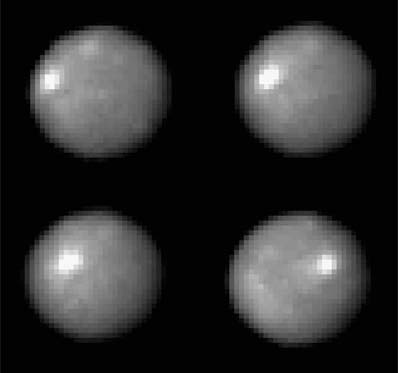Some details about the hook of the dwarf planet that made headlines, after for about a week it was crowned as a planet for everything

Editor's note: If I understood the IAU decision in Prague correctly, Ceres is both a dwarf planet and a large asteroid, currently it is a double classification, and similarly, Pluto and Charon are both dwarf planets and Kuiper belt objects. father.
There are still no photographs of the surface of Keres, however the data accumulated so far, even though they are few, can give a preliminary idea about its characteristics. Ceres is an asteroid slightly flattened at its poles. Its diameter at the equator is 970 km and between its poles 930 km. The explanation for this is its relatively high axial speed. It rotates around its axis once every 9 hours, which means its axial speed is 316 km/h. Its angle of inclination is small � 5 ± � 4. There is currently an estimate that it has an atmosphere. What components are in the atmosphere, if indeed there is one, is unknown. In terms of the seasons, if indeed there are any, the differences between them are minimal.
An interesting and surprising figure is that during the day a temperature of -34°C was measured on its surface. A high temperature, which means that beneath the ground there are sources emitting heat that comes out through cracks such as those found at the south pole of Saturn's moon Enceladus. Due to the low density, 2.5 g/cm200, it is thought that there is a lot of water under the ground, about XNUMX million cubic meters, more than the amount of fresh water on Earth. These data give room for the hypothesis that it is possible to find geysers of water similar to these on Kers found on Enceladus. Some of the water freezes and turns into layers of ice that accumulate on top of each other. Another part of the water evaporates and escapes from it. It is possible that through prolonged studies with the Hubble telescope it will be possible to find clouds of water vapor near it.
Due to the rapid rotation of a hook around itself and the possibility of the existence of an atmosphere, even though its density is low and the illuminated surface is relatively warm, there is some heat transfer from the light side to the dark side. In ultraviolet observations in 1995, a spot with a diameter of 250 km was noticed and the name given to it is Piacci after the asteroid's discoverer. The assessment was that it was a crater. In observations made several years ago and with higher resolutions, the spot is no longer visible. On the other hand, two other spots were noticed which are in motion along with the asteroid around itself and it was said with confidence that these are indeed craters. It is believed that observational studies and a spacecraft that will reach it in a few years will discover more craters on its surface.
In terms of its internal structure, for a rocky core, under the crust is a layer of water 60-120 km thick and near the surface are light minerals.
Sources
"Asteroid may be embryonic planet harboring water ice."
"Ceres - Physical characteristics."
Hooked on the Hebrew Wikipedia
"Observations reveal curiosities on the surface of Asteroid Ceres."

3 תגובות
Great site
Just an inaccuracy... in the article the duration of the tour is 9 hours, and in the picture "two and a half hours - exactly a quarter of the coffee"... which is 10 hours.